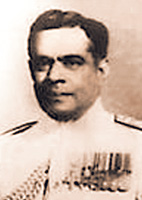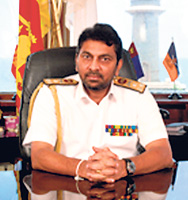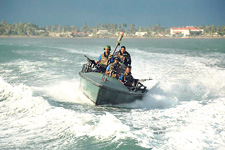Even after Sri Lanka gained Independence in February 1948, the British continued to keep the Trincomalee harbour, Katunayake airbase and some camps at Diyatalawa. Of these, Trincomalee was of strategic importance because of its location in the Indian Ocean. With the establishment of a new government in April 1956, it was decided to take them over and the British government was informed accordingly.
 |
Rear Admiral
Royce de Mel
First Sri Lankan head of the Navy |
On October 15, 1957, the Trincomalee naval base was taken over at a ceremony attended by Prime Minister S. W. R. D. Bandaranaike marking a significant milestone in the path to gaining complete independence. Sri Lanka Navy thereafter took over the administration using Trincomalee as a key naval base.
When the country was a British colony, following a decision made at the defence conference in 1932, all British colonies and dominions were advised to have its own method of security. Accordingly, the Volunteer Naval Defence Force Ordinance No. 01 of 1937 was enacted and the Ceylon Naval Volunteer Force (CNVF) was raised in the following year under the commanding officer Captain Beauchamp VRD, CBE.
With the outbreak of World War II, CNVF was called out for active service on August 31, 1939 for war duties. Three years later, Royal Navy accepted CNVF to the admiralty and renamed it 'Ceylon Royal Naval Volunteer Reserve (CRNVR).' It was then deployed for duties such as escort, guard, search and rescue operation at sea, patrolling and light house relief work.
The Royal Ceylon Navy was formed on December 9, 1950 with the passing of the Navy Act No. 34 of 1950.The officers and sailors of the CRNVR who were not demobilized were retained to form the nucleus of the upcoming navy. Captain W. E. Banks continued as Captain of the Navy. Commander G.R. (Royce) M. de Mel was sent to the United Kingdom for training to steer the navy that was emerging.
The Navy progressed slowly but steadily in the formative years. It was deployed mainly for aid to civil power and for the security of the Colombo port. Several bases were established and several craft and boats were acquired out of which Lihiniya, Hansaya, Seruwa, Diyakawa, and Korawakka (using names of popular birds) stood out.
Navy personnel stood as 48 officers and 510 sailors in 1951. The numbers grew to 136 officers and 1,650 sailors by 1957 – 58.
In 1950, the fleet was further strengthened with HMCy.S Parakramabahu, HMCy.S Mahasena and HMCy.S Gajabahu.
 |
| Vice Admiral
Wasantha Karannagoda Commander Sri Lanka Navy |
A Naval and Maritime Academy was established in Trincomalee in 1967.
The 1971 April insurgency had a great impact on the Navy. Unprepared, under-manned and under-equipped services were taken by surprise. Crews on board SLNS Gajabahu too had to be sent for fighting on land. Navy's condition grew better and recruitment drive was faster.
With the dawn of the Republic in 1972, Ceylon became Sri Lanka and Royal Ceylon Navy became 'Sri Lanka Navy' (SLN) and Captain of the Navy changed to 'Commander of the Navy.' 'Her Majesty's Ceylon' ship turned out to be 'Sri Lanka Navy' ship.
The fleet was further strengthened with the purchase of Fast Gun Boats (FGBs) – SLNS Sooraya and SLNS Weeraya from China in 1972. Three years later three more of the same type, Dakshaya, Ranakamee, and Balawatha were purchased. In 1980, Samudra Devi was donated by the then Union of Soviet Socialist Republic of Russia (USSR) to SLN. Offshore patrol craft Jayasagara and Sagarawardana built in Colombo Dockyard Ltd., too were taken over.
New roles and duties assigned and new bases were established. Coordinating officers from Navy were appointed to Polonnaruwa, Ampara and Ratnapura. SLNS Vijaya in Kalpitiya was established in 1973. Navy basically focused on anti-smuggling and anti-immigration e.g. Task Force Anti Illicit Immigration – Tafaii.
 |
| A locally built boat of the Navy's Rapid Action Boat Squadron (RABS) |
In the 1980s, the whole scenario changed with the dawn of terrorism. A sea patrol from SLNS Elara 'Karainagar' detected a suspicious boat and when it landed ashore; Navy apprehended an occupant who was trying to shoot himself. Later he was handed over to the police. It was Kuttimani, the then de facto leader of the terror outfit. Jegan, another terrorist leader, also was apprehended by the Navy.
The 1983 – 1987 period marked the escalation of separatist terrorism. Killings and robberies became rampant. With the launch of Operation Liberation (Vadamarachchi Operation) the Navy engaged in transportation of troops and logistics, support and relief activities in the operational area. From then onwards the Navy has been extremely busy both in the North and the East. |



